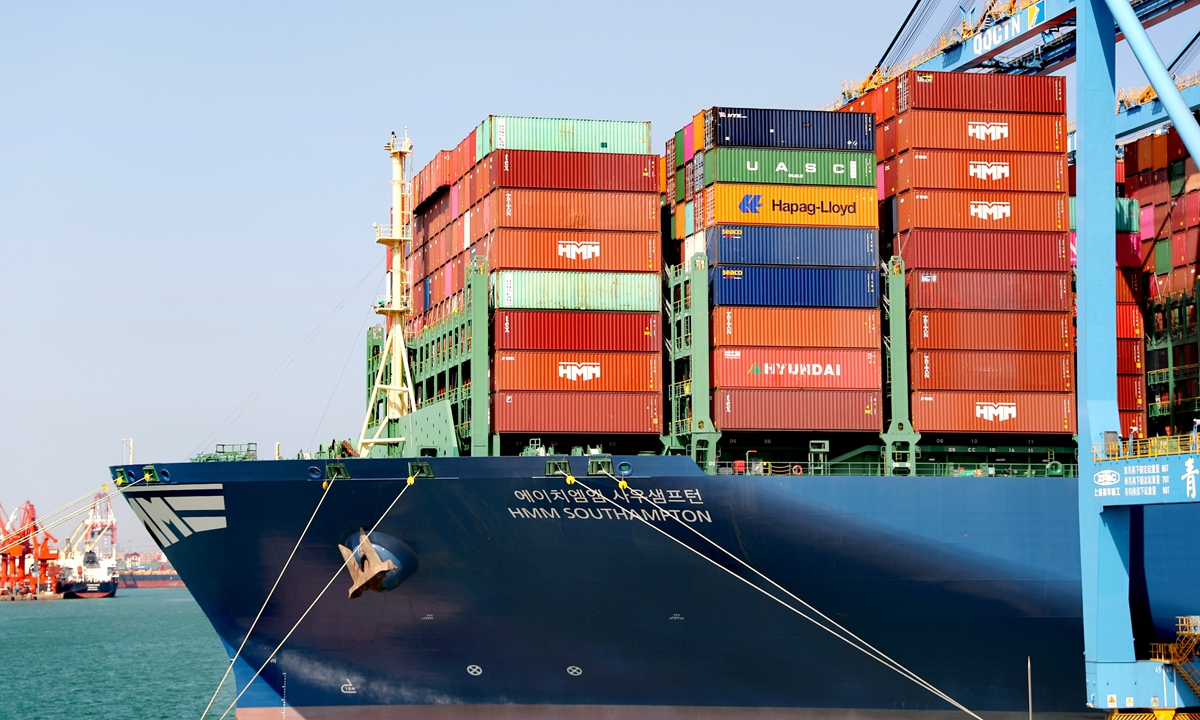
A ship loading foreign trade goods at Qingdao Port Fully Automated Container Terminal in East China's Shandong Province on Wednesday. Photo: cnsphoto
China's marine shipping for exports to the EU and the US has been affected by the disruption of two prominent global canals - the Panama Canal and the Suez Canal - due to drought and geopolitical factors, leading to a surge in shipping costs and delivery delays, Chinese industry insiders told the Global Times on Sunday.
Yemen's Houthi movement said on Saturday that it would target all ships heading to Israel, regardless of nationality, and warned all international shipping companies against dealing with Israeli ports, Reuters reported.
Due to the ongoing Israel-Palestine conflict, many cargo ships have chosen to bypass the Suez Canal, which is a crucial shipping route connecting China with the EU market. The straight-line distance from the Suez Canal to the Gaza Strip is less than 200 kilometers, domestic futures news site qhrb.com reported.
The Panama Canal, another trade route carrying many of China's commodities to the US market, is suffering its worst-ever drought, according to a report by the Daily Mail on Thursday. The report said that dozens of massive container ships carrying presents and festive items for Christmas including Apple's new iPhones, TVs, exercise bikes, clothes and tree lights are experiencing delays of up to four weeks.
Shipping companies have been dealing with delivery delays and additional costs resulting from the disruption of the two canals, Wu Minghua, a veteran shipping analyst, told the Global Times on Sunday.
For instance, deliveries heading to the US East Coast via the Panama Canal now may be unloaded in ports in Los Angeles, Long Beach and other places on the US West Coast and transferred to the East Coast through land or railway transportation. That means higher transportation expenditures, Wu said.
The Panama Canal Authority announced on November 24 that it would offer a special auction slot starting on November 25, with the purpose of providing more opportunities of obtaining a slot for vessels in the Panamax Locks that have been waiting in the transit line for an extended period.
China is the second-largest user of the Panama Canal, accounting for 21.4 percent of the canal's total freight volume in the financial year of 2022, stcn.com reported.
Additional charges for shipping companies such as the auction fee may be passed on to the shippers, Zheng Ping, chief analyst with industry news portal chineseport.cn, told the Global Times on Sunday.
In terms of the Suez Canal, Wu said that shipping companies may increase their insurance coverage.
Meanwhile, Wu noted that companies may start shipping preparations even earlier due to the potential delays and changes in routes, as the Chinese New Year in February 2024 will be another peak. For example, if ships bypass the Suez Canal, they would choose routes like the Cape of Good Hope and the journey will take around 10 more days to reach ports in Europe.
Zheng also noted that external demand from overseas markets such as the US has been weakened because of inflation and interest rate hikes.
Official data from China's Ministry of Transport showed that the cargo throughput for foreign trade handled by China's ports reached 4.2 billion tons in the first 10 months of the year.




